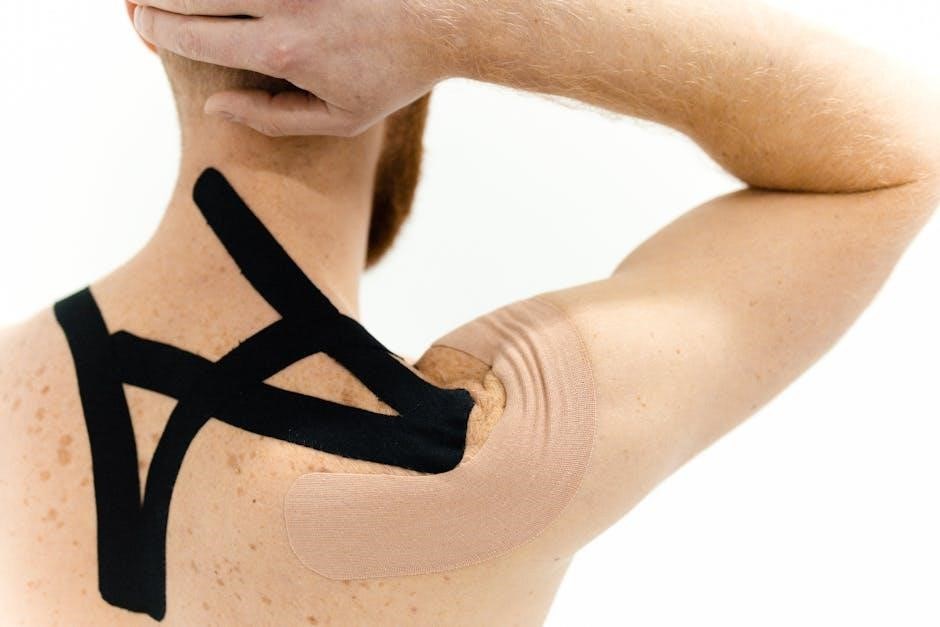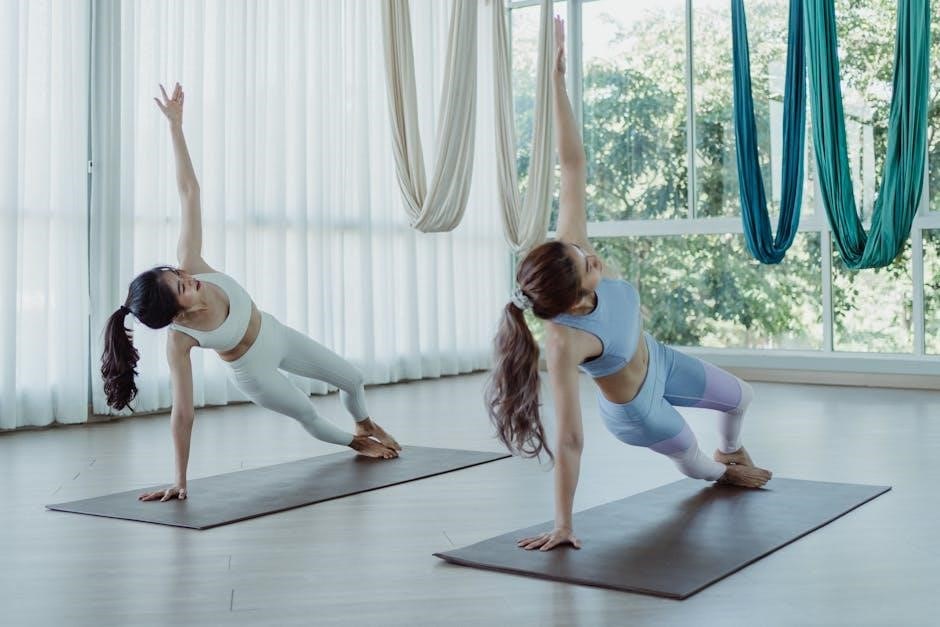Shoulder stabilization exercises are essential for preventing injuries and enhancing mobility. They target the scapula and rotator cuff‚ improving strength and control. These exercises are often prescribed by physical therapists to support rehabilitation and sports performance‚ ensuring long-term shoulder health and stability.
Importance of Shoulder Stability
Shoulder stability is crucial for maintaining proper joint function and preventing injuries. The shoulder‚ being one of the most mobile joints‚ relies heavily on muscular control to ensure smooth movement. A stable shoulder minimizes the risk of dislocations and strain‚ particularly for athletes and individuals with active lifestyles. Weak shoulder stability can lead to poor posture‚ reduced strength‚ and chronic pain. Strengthening the scapula and rotator cuff muscles through targeted exercises enhances overall shoulder health. Improved stability also boosts athletic performance and reduces the likelihood of long-term damage‚ making it a cornerstone of both rehabilitation and injury prevention programs.
Overview of Shoulder Stabilization Exercises
Shoulder stabilization exercises are a structured program designed to enhance the strength and control of the shoulder joint. These exercises target the scapula‚ rotator cuff‚ and surrounding muscles to improve joint stability. The exercises are typically divided into phases‚ starting with foundational movements like pendulum exercises and scapular setting‚ progressing to intermediate and advanced routines. They incorporate techniques such as wall push-ups‚ arm circles‚ and resistance band rotations to build endurance and coordination. Dynamic stabilization exercises‚ including unilateral rowing and scapular wall slides‚ further challenge the shoulder’s ability to maintain control during movement. The goal is to restore proper shoulder mechanics‚ prevent injuries‚ and promote long-term joint health through consistent practice and progression.
Benefits of Shoulder Stabilization Exercises
Shoulder stabilization exercises offer numerous benefits‚ including enhanced joint stability‚ improved range of motion‚ and reduced injury risk. They strengthen the rotator cuff and scapular muscles‚ crucial for proper shoulder mechanics. These exercises also promote better posture and reduce shoulder pain‚ especially for athletes and individuals with repetitive arm movements. By improving dynamic control‚ they enhance athletic performance and support rehabilitation. Consistent practice fosters long-term shoulder health‚ preventing chronic issues like subacromial impingement. Overall‚ these exercises are a cornerstone for maintaining strong‚ flexible‚ and resilient shoulders‚ essential for both daily activities and sports performance.

Phase I: Foundational Shoulder Stabilization Exercises
Phase I focuses on building basic strength and stability through gentle exercises like pendulum swings‚ shoulder blade squeezes‚ and wall push-ups. These movements improve mobility and reduce injury risk while laying the groundwork for more advanced training.
Pendulum Exercises
Pendulum exercises are foundational for shoulder stabilization‚ focusing on gentle‚ controlled movements to enhance mobility and reduce stiffness. Begin by bending at the waist‚ balancing with your uninjured arm. Allow your affected arm to relax and swing freely under gravity‚ performing small circles inward and outward‚ as well as swings in North/South and East/West directions. These exercises improve joint mobility without overloading the shoulder. They are typically performed in the initial stages of rehabilitation and are supervised by a physiotherapist to ensure proper form and progression. Regular practice helps restore natural shoulder movement and prepares the joint for more advanced exercises.
Shoulder Blade Setting and Squeezes
Shoulder blade setting and squeezes are fundamental for improving posture and reducing injury risk. Stand or sit with good posture‚ engage your core‚ and gently squeeze your shoulder blades together without shrugging. Hold for 5-10 seconds‚ then relax. Perform 10-15 repetitions. This exercise strengthens the muscles between your shoulder blades‚ enhancing scapular stability. Avoid arching your back or using excessive force‚ as this can strain the shoulders. Start with shorter holds and gradually increase duration as strength improves. Consistency is key to developing proper shoulder mechanics and preventing imbalances. This exercise is often paired with other stabilization drills for comprehensive shoulder health.
Wall Push-Ups
Wall push-ups are an excellent exercise for improving shoulder stability and strength. Stand facing a wall with your hands at shoulder height and feet shoulder-width apart. Slowly lower your body toward the wall by bending your elbows‚ keeping your elbows close to your body. Push back to the starting position‚ ensuring controlled movements. This exercise strengthens the shoulder muscles‚ enhances scapular stability‚ and is low-impact‚ making it ideal for rehabilitation or beginners. Perform 10-15 repetitions for 2-3 sets. Focus on proper form to avoid injury and gradually increase difficulty as strength improves. Wall push-ups are a great foundational exercise for shoulder health.
Scapular Depression Exercises
Scapular depression exercises focus on strengthening the muscles that pull the shoulder blades downward. Start by standing or sitting with good posture. Engage your core and gently pull your shoulder blades down without arching your back. Hold for 5 seconds‚ then release. Repeat for 10-12 repetitions. This exercise targets the latissimus dorsi and trapezius muscles‚ improving scapular stability. For progression‚ use resistance bands or light weights. Perform 2-3 sets‚ ensuring controlled movements. Scapular depression is crucial for maintaining proper shoulder mechanics and preventing injuries. It enhances posture and reduces the risk of shoulder impingement‚ making it a key component of shoulder stabilization programs.

Phase II: Intermediate Shoulder Stabilization Exercises
Phase II introduces intermediate exercises like arm circles‚ shoulder clock‚ and banded rotations to enhance strength and control. These exercises improve mobility and stability‚ preparing for advanced movements.
Arm Circles
Arm circles are an effective intermediate exercise for improving shoulder mobility and stability. Stand with your arms extended straight out to the sides at shoulder height. Make small‚ controlled circles forward and backward for 5-10 repetitions in each direction. This exercise targets the deltoids and enhances flexibility. Keep your shoulders relaxed and avoid shrugging. Gradually increase the size of the circles as your range of motion improves. Perform 2-3 sets daily to strengthen the shoulder joint and scapular muscles. Arm circles are ideal for athletes and individuals recovering from injuries to restore proper movement patterns and prevent future shoulder issues.
Shoulder Clock Exercise
The shoulder clock exercise is a dynamic movement that enhances scapular stability and rotator cuff strength. Stand with good posture‚ arms at your sides‚ and palms facing forward. Slowly lift one arm to shoulder height‚ keeping it straight‚ and internally rotate your shoulder as if pointing to 12 o’clock on an imaginary clock. Lower your arm and repeat with the other shoulder. Perform 8-10 repetitions on each side. This exercise improves shoulder mobility and control‚ making it ideal for rehabilitation and injury prevention. Focus on maintaining proper form and avoiding shoulder shrugging. Incorporate this exercise into your routine 2-3 times daily for optimal results.
Banded External and Internal Rotations
Banded external and internal rotations are effective exercises for improving shoulder stability and rotator cuff strength. Attach a resistance band to a stable object at shoulder height. Hold the band with your hand‚ keeping your elbow close to your body. For external rotation‚ pull the band outward‚ keeping your arm at a 90-degree angle‚ then return to the starting position. For internal rotation‚ pull the band toward your stomach‚ maintaining proper form. Perform 8-10 repetitions in each direction. This exercise enhances joint stability and prevents injuries‚ making it ideal for athletes and individuals with shoulder instability. Use a light to moderate resistance level and focus on controlled movements for maximum benefit.
Lateral Raises with Proper Form
Lateral raises are a fundamental exercise for enhancing shoulder stability and strength. Stand with good posture‚ feet shoulder-width apart‚ and hold light dumbbells at your sides. Engage your core and maintain a slight bend in your elbows. Raise your arms to shoulder level‚ keeping them straight‚ and avoid shrugging your shoulders. Focus on controlled movements‚ ensuring your shoulders remain stable throughout the exercise. Lower your arms slowly to the starting position. Perform 8-10 repetitions for 2-3 sets‚ 3-4 times a week. Proper form prevents injury and targets the deltoid muscles effectively‚ promoting shoulder stability and overall strength.

Phase III: Advanced Shoulder Stabilization Exercises
Phase III focuses on advanced techniques to enhance shoulder stability and strength. Resistance band pull-aparts and stability ball push-ups challenge dynamic control. Arm bars and scapular stabilization drills improve endurance and precision‚ preparing shoulders for high-level activities and sports.
Resistance Band Pull-Aparts
Resistance band pull-aparts are an advanced exercise targeting scapular stabilization and shoulder strength. Hold the band with arms extended‚ squeezing your shoulder blades together as you pull the band apart. Focus on slow‚ controlled movements to maximize muscle activation. This exercise strengthens the rotator cuff and scapular stabilizers‚ improving posture and reducing injury risk. It’s ideal for athletes and individuals with shoulder instability‚ as it enhances dynamic control and endurance. Perform 3 sets of 12-15 repetitions‚ maintaining proper form to avoid shrugging or using momentum. This drill is highly effective for advanced shoulder rehabilitation and sports performance training.
Advanced Stability Ball Push-Ups
Advanced stability ball push-ups are a challenging exercise for enhancing shoulder stabilization and core engagement. Perform by placing your hands on the ball and feet on the ground‚ maintaining a plank position. Lower your chest toward the ball while keeping elbows close to your body‚ then push back up. Focus on controlled movements to activate the rotator cuff and scapular stabilizers. This exercise improves dynamic stability‚ strength‚ and endurance. Start with 3 sets of 8-10 repetitions‚ ensuring proper form to avoid shoulder shrugging or losing core engagement. It’s an excellent progression for those with a strong foundation in shoulder stabilization and core strength.
Scapular Stabilization with Dynamic Movements
Scapular stabilization with dynamic movements combines controlled arm movements with scapular engagement to enhance shoulder stability and strength. Start with your arms extended overhead‚ then lower them slowly while maintaining scapular depression. Alternate between internal and external rotations‚ ensuring the scapula remains stable. Use resistance bands for added challenge. Perform 3 sets of 10-12 repetitions‚ focusing on smooth transitions. This exercise improves functional strength and dynamic control‚ crucial for overhead activities and sports. Ensure proper form by avoiding shoulder shrugging and maintaining core engagement throughout the movement. Regular practice enhances joint stability and reduces injury risk.
Arm Bars for Enhanced Stability
Arm bars are advanced exercises that improve shoulder stability by engaging the rotator cuff and scapular stabilizers. Hold a light weight or resistance band overhead with arms extended. Slowly lower the bar behind your head while maintaining shoulder stability‚ then return to the starting position. Perform 3 sets of 8-10 repetitions‚ focusing on controlled movements. This exercise strengthens the muscles responsible for dynamic shoulder stability‚ reducing injury risk and enhancing athletic performance. Ensure proper form by keeping the elbows slightly bent and avoiding excessive shoulder shrugging. Incorporate arm bars into your routine for advanced shoulder stabilization and improved functional strength.

Role of the Scapula in Shoulder Stabilization
The scapula plays a crucial role in shoulder stability by providing a stable base for the shoulder joint. Scapular retraction and depression enhance shoulder stability during movements‚ ensuring proper joint alignment and reducing injury risk.
Scapular Retraction and Depression Techniques
Scapular retraction involves squeezing the shoulder blades together‚ while depression focuses on pulling them downward. Both techniques enhance shoulder stability by improving posture and reducing injury risk. Proper execution requires engaging core muscles and maintaining controlled movements. These exercises strengthen the scapular stabilizers‚ essential for optimal shoulder function. Regular practice improves joint alignment and prevents excessive shoulder mobility. Incorporating these techniques into daily routines promotes long-term shoulder health and stability‚ making them a cornerstone of effective shoulder stabilization programs.
Scapular Push-Ups
Scapular push-ups target the muscles around the shoulder blades‚ improving stability and strength. Start in a plank position‚ engage the core‚ and lower your body slightly. Keeping your arms straight‚ focus on squeezing your shoulder blades together as you push back to the starting position. Avoid shrugging your shoulders or letting your hips sag. This exercise enhances scapular control and reduces injury risk. Begin with knee.push-ups if needed‚ and progress to incline surfaces for increased challenge. Regular practice strengthens the serratus anterior and trapezius muscles‚ essential for shoulder stability and overall upper-body movement efficiency.
Scapular Stabilization Drills
Scapular stabilization drills are designed to enhance the shoulder’s ability to maintain proper positioning during movements. These exercises often involve controlled arm movements while keeping the shoulder blades steady. One common drill is the wall slide‚ where you stand facing a wall and slide your arms upward while keeping your shoulders down and away from your ears. Another effective drill is the scapular push-up‚ which focuses on squeezing the shoulder blades together as you lower and raise your body. These drills improve muscle activation patterns‚ reducing the risk of injury and improving overall shoulder function. Consistent practice strengthens the muscles around the scapula‚ promoting better posture and movement efficiency.

Dynamic Stabilization Exercises
Dynamic stabilization exercises involve moving your arms while maintaining shoulder blade control‚ enhancing real-world movement stability. Examples include wall slides and rows‚ improving muscle activation and injury prevention.
Unilateral Rowing Exercises
Unilateral rowing exercises strengthen each shoulder independently‚ improving stability and reducing muscle imbalance. Using resistance bands or light dumbbells‚ perform rows with one arm while keeping the other stationary. Focus on controlled movements‚ engaging the scapula by pulling your shoulder blade toward your spine during the row. This exercise enhances functional kinetic chain activation‚ crucial for injury prevention and athletic performance. Proper form is essential to avoid compensatory movements. Start with lower resistance and progress gradually‚ ensuring each repetition maintains scapular control and avoids shrugging. This targeted approach helps build resilience in the shoulder joint and surrounding muscles‚ promoting long-term stability and strength.
Dynamic Scapular Wall Slides
Dynamic scapular wall slides enhance scapular mobility and stability by combining movement with controlled positioning against a wall. Stand with your back against the wall and arms extended overhead‚ palms facing forward. Slowly slide your arms downward‚ maintaining contact with the wall‚ while retracting and depressing your shoulder blades. This exercise improves scapular kinematics and reduces impingement risk. Focus on smooth‚ pain-free motion‚ avoiding shoulder shrugging. Perform 3 sets of 10-12 repetitions‚ progressing as comfort allows. This drill is ideal for addressing scapular winging and promoting dynamic stability‚ essential for overhead activities and athletic performance.
Functional Kinetic Chain Exercises
Functional kinetic chain exercises integrate shoulder movements with other body segments to enhance coordination and strength. These exercises mimic real-life and sport-specific movements‚ improving shoulder stability by engaging the entire kinetic chain. They focus on dynamic scapular control‚ rotator cuff activation‚ and proper movement patterns. Examples include overhead presses with scapular rotation and rotational rowing motions. Regular practice reduces injury risk and enhances athletic performance by improving joint sequencing and muscle synchronization. These exercises are particularly beneficial for athletes and individuals with active lifestyles‚ as they promote functional strength and stability across the entire shoulder complex.

Progression and Frequency of Exercises
Exercises should progress from basic to advanced‚ focusing on strength and control. Aim for 3-4 sessions weekly‚ with 2-3 sets of 8-12 repetitions to enhance shoulder stability and strength.
Exercise Progression Strategies
Exercise progression involves gradually increasing intensity and complexity. Start with foundational movements like pendulum exercises and scapular squeezes‚ ensuring proper form and control. As strength improves‚ introduce intermediate exercises such as arm circles and banded rotations. Advanced stages incorporate dynamic movements and resistance bands to challenge stability. Each progression should focus on maintaining proper posture and avoiding compensation patterns. It’s crucial to master each phase before advancing to prevent injury and ensure effective shoulder stabilization. Progression strategies should be personalized‚ considering individual strength levels and goals‚ to optimize outcomes and promote long-term shoulder health.
Recommended Frequency and Sets
Shoulder stabilization exercises should be performed 3-4 times per week for optimal results. Begin with 2-3 sets of 8-12 repetitions for each exercise‚ gradually increasing as strength and control improve. Rest periods of 30-60 seconds between sets are recommended to maintain focus and proper form. Consistency is key‚ as irregular practice may hinder progress. Start with lower sets and reps for foundational exercises‚ then progress to higher volumes as stability improves. Always prioritize maintaining proper posture and technique to avoid injury. A well-structured routine ensures steady improvement in shoulder strength and stability over time. Consult a physical therapist to tailor the program to individual needs and goals.

individualization of the Exercise Program
Individualization of the Exercise Program
A personalized exercise program is crucial for effective shoulder stabilization. A physical therapist assesses the individual’s shoulder condition‚ strength‚ and movement patterns to tailor exercises. Programs are adjusted based on pain levels‚ strength deficits‚ and functional goals. Modifications include varying sets‚ reps‚ and resistance levels. For example‚ those with severe instability may start with isometric exercises‚ while others progress to dynamic movements. Exercises are phased to gradually challenge the shoulder‚ ensuring proper technique and avoiding aggravation of existing injuries. Regular reassessment every 4-6 weeks helps refine the program‚ ensuring continuous progress toward improved shoulder stability and function; This approach maximizes safety and effectiveness for each individual.

Common Mistakes and Troubleshooting
Poor posture and shoulder shrugging during exercises can reduce effectiveness. Ensure proper form and avoid overreliance on momentum. Correct scapular winging by engaging core and maintaining stabilization throughout movements.
Postural Awareness During Exercises
Maintaining proper posture is crucial during shoulder stabilization exercises to ensure effectiveness and prevent injury. Keep your chest elevated‚ shoulders back‚ and spine aligned. Avoid slouching or leaning forward‚ as this can strain the shoulders and reduce the exercise’s impact. Engage your core to support your body and maintain stability. Ensure your neck remains neutral‚ avoiding tilting or stretching. For exercises like arm circles or wall push-ups‚ keep your shoulders relaxed and away from your ears. Correcting posture mid-exercise helps maximize benefits and promotes proper muscle activation. Consistent postural awareness enhances overall shoulder stability and reduces the risk of compensatory movements.
Avoiding Shoulder Shrug During Movements
Avoiding shoulder shrug during exercises is vital to maintain proper form and prevent injury. Shrugging can lead to poor mechanics and strain on the neck and upper traps. Keep your shoulders relaxed and down‚ avoiding elevation during movements like arm circles or lateral raises. Focus on engaging your scapular stabilizers instead. Practice controlled‚ slow movements to enhance awareness. If shrugging occurs‚ pause and reset your posture. Consistent practice helps develop muscle memory‚ reducing the likelihood of shrugging and promoting effective shoulder stabilization. This ensures exercises target the correct muscles and enhance overall shoulder health and stability.
Correcting Scapular Wingin
Scapular winging‚ where the shoulder blade protrudes‚ often results from weak serratus anterior muscles. To correct this‚ focus on exercises that strengthen the scapular stabilizers‚ such as wall slides and push-ups. Practice scapular squeezes and rotations to improve muscle activation. Ensure proper posture and engage your core during exercises to support scapular positioning. Using resistance bands can also help reinforce correct movement patterns. Progress gradually‚ increasing resistance as strength improves. Consistency in these exercises helps restore proper scapular mechanics and reduces winging‚ enhancing overall shoulder stability and function.
Consistent practice of these exercises enhances shoulder stability‚ prevents injuries‚ and improves mobility. For personalized programs‚ consult a physical therapist to ensure effectiveness and safety in your routine.
Key shoulder stabilization exercises include shoulder blade squeezes‚ pendulum exercises‚ wall push-ups‚ and scapular push-ups. These are foundational for building stability. Progress to arm circles‚ shoulder clock exercises‚ and resistance band pull-aparts for intermediate strength. Advanced exercises involve dynamic movements and arm bars. Each phase targets specific muscle groups‚ ensuring comprehensive shoulder stability and injury prevention. Regular practice of these exercises enhances joint health and functional mobility‚ making them essential for both rehabilitation and sports performance. Consistency and proper form are crucial for maximizing benefits and preventing further injuries. These exercises form a structured program to achieve strong‚ stable shoulders.
Long-Term Benefits of Consistent Practice
Consistent practice of shoulder stabilization exercises offers numerous long-term benefits‚ including enhanced joint stability‚ reduced injury risk‚ and improved overall mobility. Regular engagement strengthens the rotator cuff and scapular muscles‚ which are crucial for maintaining proper shoulder mechanics. Over time‚ this leads to better posture‚ reduced pain‚ and increased athletic performance. These exercises also promote muscle balance and prevent chronic conditions like subacromial impingement. By incorporating them into a daily routine‚ individuals can achieve lasting shoulder health‚ enabling them to perform daily activities and sports with confidence and efficiency. The cumulative effect ensures sustained strength and resilience‚ making consistent practice invaluable for long-term shoulder well-being.

Resources for Further Learning
For deeper understanding and practical guidance‚ numerous resources are available‚ including detailed PDF guides‚ instructional videos‚ and physical therapy websites. Websites like sportsrehab.ucsf.edu offer comprehensive exercise manuals‚ while YouTube channels provide visual demonstrations of techniques. Books on physical therapy and online courses also serve as valuable tools. Additionally‚ consult with a physical therapist for personalized programs. These resources ensure a well-rounded approach to mastering shoulder stabilization exercises‚ helping you achieve optimal results and maintain long-term shoulder health. Regularly exploring these materials will enhance your knowledge and skill in performing the exercises effectively.
